10 FAQs About Sentinel node Biopsy for Breast Cancer
During the past eighteen years in my medical practice, I’ve had a direct impact (I hope a positive impact) on breast cancer treatment for over a thousand women confronting this diagnosis. During this time span the DECISION MAKING process has become increasingly complex.
This article is also available en Espanol
FOREWORD
During the past eighteen years in my medical practice, I’ve had a direct impact (I hope a positive impact) on breast cancer treatment for over a thousand women confronting this diagnosis. During this time span the DECISION MAKING process has become increasingly complex. Breast cancer is varied in its presentation and biological behavior, and while awareness of disease variability is a necessity for clinical practitioners, the array of choices in treatment can be confusing for the individual patient. Clear-cut decisions about crucial aspects of an individual woman’s care are difficult to discern, a situation that tactically leads to uncertainty. Information tends to sound less credible when it is qualified by statistical estimates not fully comprehensible to most patients or their families. I never really thought it was fair to drop a load of information on some bewildered patient and then dismiss them with the ultimatum to "call back next week with your decision".
As a surgeon, one of those difficult decisions that I influence in women with breast cancer is whether or not to remove regional lymph nodes in order to clinically "stage" a particular breast cancer. STAGING is the process of assigning a cancer at the time of its diagnosis to a numerical category that implies something about its future. Staging also allows more accurate comparisons of various treatment strategies among patients whose cancers have similar attributes. Staging is an attempt to place a rational reference device over the varied spectrum of breast cancer in order to make choices that we as patient and doctor can live with and confidently state: "Given my choices, I chose the best treatment plan for me as individual".
Staging criteria are somewhat varied but they usually include some measurement of tumor size and some assessment of whether or not the cancer has metastasized to regional lymph nodes i.e. tiny aggregates of immunologically active tissue through which the extra-cellular fluid of the body circulates as it leaves the breast. Most of this fluid is circulated through lymph nodes under the arm, a region of the body usually referred to as the "axilla"; hence the term axillary lymph nodes. Operative removal of these nodes is referred to as an axillary lymph node dissection (ALND). THIRTY-FORTY PERCENT of women with breast cancer will demonstrate REGIONAL NODE METASTASES. Detection of lymphatic cancer usually leads to some recommendation for systemic treatment (chemotherapy or hormone-antagonist) and places the cancer into a less favorable stage in terms of overall survival. Of course lots of breast cancer patients should use SYSTEMIC THERAPY (some would say almost all invasive cancers should be treated with anti-cancer drugs). I submit to you without further elaboration that knowledge regarding axillary node involvement is a useful piece of information to plug into the treatment scheme.
New data about how cancers spread within the network of axillary nodes combined with some time-tested technology has made the staging of the axilla an easier operation with fewer unpleasant and harmful side effects for the patient. This process has become known as a SENTINEL NODE BIOPSY (SLND). Here are the commonly asked questions about the procedure.
10 FAQs About Sentinel node Biopsy for Breast Cancer
- WHAT IS THE SENTINEL LYMPH NODE?
The sentinel lymph node is the first node(s) in the body to come into contact with the cancer cells as they leave the organ of origination and start to spin off or spread into the rest of the body’s tissues. In the context of breast cancer the usual location for the sentinel node (SN) is under the arm, although for cancers on the inner or medial aspect of the breast, the SN may be inaccessible in nodes beneath the breast bone or sternum. - WHY IS THE SN IMPORTANT IN THE TREATMENT OF BREAST CANCER?
Testing for metastatic cancer cells in the SN allows accurate staging using information from a single lymph node or a small number of nodes. Since the risk for positive axillary nodes ranges from 0 to 40 percent, many women could undergo SLND (Sentinel lymph node dissection) rather than complete axillary lymph node dissection (ALND) and in the process gain accurate information about the rest of the lymph nodes in the network without enduring the trauma of ALND. In other words IF THE SN NODE(S) WERE FOUND NEGATIVE, one would not have to remove more or excessive numbers of lymph nodes to get all the information needed to accurately stage the axilla and the cancer. - WHAT ARE THE ADVANTAGES OF SLND OVER TRADITIONAL AXILLARY NODE DISSECTION (ALND)?
Many times in counseling patients I am asked by those who still have their wits about them: " Well lymph nodes must be there for a reason"? And they’re absolutely right. The lymphatics are a vital part of the micro-circulation. They serve as channels through which the base liquid of the body ( the extra-cellular fluid) is re-routed into the circulatory system. The lymph nodes serve to filter the liquids and to maintain the sterility through the actions of the immune system, elements of which are found in the nodes in abundance. Removal of critical numbers of lymph nodes interrupts the re-routing process and can lead to congestion of the tissues served by regional lymphatics. Sentinel lymph node biopsy limits the disruption, and makes congestion of the arm or the breast, a condition called LYMPHEDEMA, an unlikely event. In addition since the trauma of surgery is decreased, patients have fewer complaints of nerve injury or PARESTHESIA after SLND. Clinical lymphedema does not occur in everyone undergoing an axillary node dissection, but it occurs often enough to be a problem for many especially if they are athletic and active, and it is incurable and life-long. - WHO IS A CANDIDATE FOR SENTINEL LYMPH NODE BIOPSY?
Women with a biopsy-proven invasive breast cancer should consider SLND as an alternative to a traditional ALND. Remember that non-invasive or in situ carcinomas seldom require ANY dissection of the axillary nodes since non-invasive cancers by their very definition have not invaded the spaces around the mammary duct and therefore lack access to the rest of the body. - WHO IS NOT A CANDIDATE FOR SLND?
Several circumstances disqualify patients for SLND and make traditional ALND a better choice. Patients who have obviously INVOLVED lymph nodes should have a complete axillary nodal dissection because it’s always a good policy to remove any cancer accessible to the surgeons. I’ve had problems accurately mapping the axilla in patients who have had large biopsies or "lumpectomies". Something about the surgical procedure itself disturbs the lymphatic circulation and interrupts the flow from the breast into the underarm and makes the precise identification of the "sentinel" node impossible. The LOCATION of the primary cancer may (inner aspect of breast or axillary tumor) interfere with nuclear isotope labeling or indicate a sentinel node in an inaccessible position like the intra-thoracic internal mammary nodes. Finally patients with LARGE tumors (>5 cm) should consider having chemotherapy first prior to any definitive treatment of the breast or the axilla because the disease is presumed to be systemic anyway for Stage III cancers. - HOW IS A SENTINEL NODE BIOPSY PERFORMED?
Remember that the lymphatic system is part of the circulatory system and microscopic in proportion. In order to identify the precise anatomy of this system, some type of marker or brilliantly-colored dye has to be injected into the breast near the tumor site and followed as the component parts of this microvascular tree fill. Ultimately the lymph nodes under the arm pick up whatever tracer has been injected into the breast. At Presbyterian Hospital we employ first a RADIO-ISOTOPE which is injected into the breast a few hours before scheduled surgery in the Department of Nuclear Medicine AND secondly a neon-BLUE DYE which is used intra-operatively. I use both techniques currently to identify the first or first few nodes demonstrated in the axilla. Research has shown that when one or both techniques are successful, then we can be confident that the "sentinel" lymph node has been identified. It is common to identify more than one node by either it’s radio-active signal or by the characteristic blue coloration. - IS ADDITIONAL TREATMENT NECESSARY AFTER SLND?
Generally speaking, YES, but further surgery may not be indicated depending on careful pathologic analysis of the lymphatic tissues submitted. Our pathologists at Presbyterian take the individual nodes and study them in great detail utilizing advanced biochemical and immunologic methods. If the SN contains even a tiny microscopic deposit of cancer (a micrometasis), then other nodes are potentially involved and a more extensive ALND is performed at a later date. On the other hand if the SN is NEGATIVE, the inference is that the REMAINING NODES are NEGATIVE ALSO and that the axilla has been successfully staged. Assuming that no further surgical treatment of the breast is necessary, patients then proceed to systemic chemotherapy or radiotherapy depending on which treatment is recommended. - WHAT ARE THE RISKS ASSOCIATED WITH SLND?
The greatest risk is that the sentinel node will test negative and not accurately signal metastatic cancer within the underarm region or axilla. In the series reported in the world’s scientific literature, the percentage of false negatives is about two per cent at several institutions. The chief safeguard against a false negative result is the experience of personnel involved, their insistence on strict criteria for the identification of the sentinel nodes and their inclination to extend the procedure should the mapping techniques not meet strict criteria. The amount of radiation exposure with the isotope portion is negligible, and the blue dye is harmless other than giving the patient a Smurf-like hue for a few hours. There’s usually a bluish stain around the "lumpectomy" for a few weeks. - HOW LONG DOES THE PROCEDURE TAKE?
Theoretically the procedure should be quicker than a standard ALND, usually about 45 minutes. If the procedure includes additional breast surgery add another 30-45 minutes to the total. The overall time is shorter for thinner patients who don’t have a bulky underarm. I usually have the patients lightly anesthetized especially if they are having the tumor site re-excised at the same time. - SHOULD SENTINEL LYMPH NODE BIOPSY BE CONSIDERED AN EXPERIMENTAL PROCEDURE?
At Presbyterian Hospital Dallas we are offering the procedure to selected individuals with proven breast cancer "off-protocol" or without an immediately following ALND. In my opinion the procedure has met the challenge of thorough clinical testing and should NOT be considered an experimental procedure. In the world’s scientific literature the false negative rate is about 2%. I think that figure which has been reported from various other institutions and continents is sufficiently low and the benefits so obvious that it is time to put theory into practice. My view is influenced by a personal experience treating over one thousand breast cancers and the consequences of that treatment including many women who suffered from incurable lymphedema after a totally negative ALND.
Images:
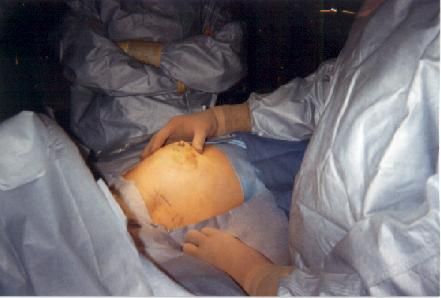


Breast Prepared for Sterile Procedure
Senitel Node site confirmed with Gamma Counter
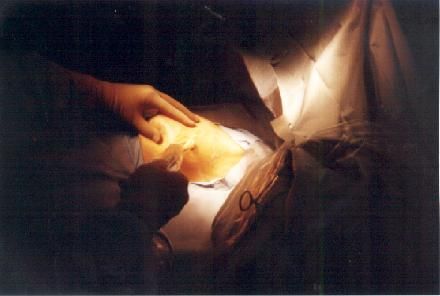
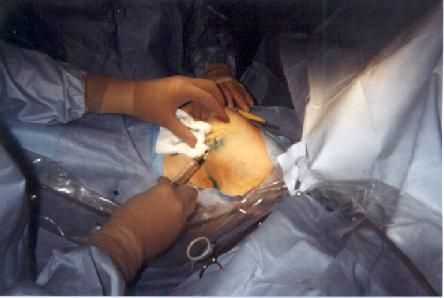
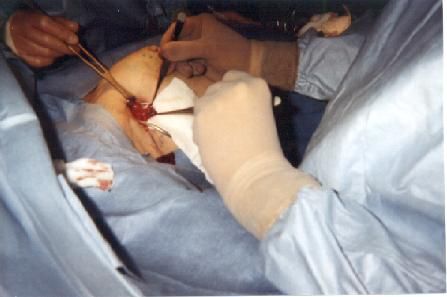
Senitel Node site confirmed with Gamma Counter
Injection of Blue Dye
Lymphatics exposed in lower axilla
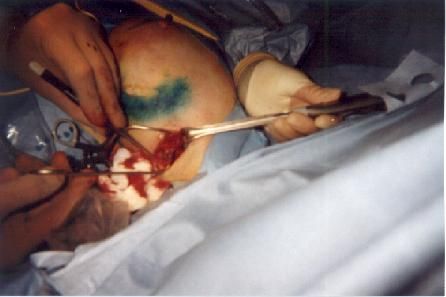

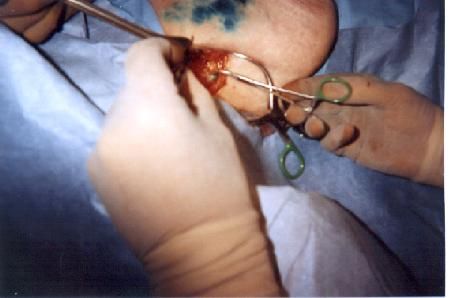
Blue Stained Lymph Nodes removed through small incision



Breast incision closed after lymph node biopsy
Typical specimen sent to pathology for analysis

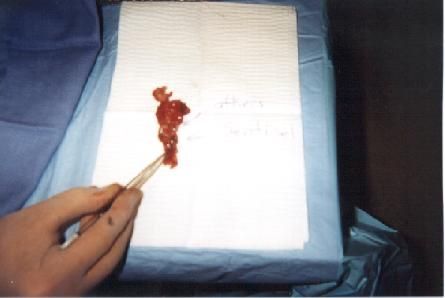

Typical specimen sent to pathology for analysis
(click on each image to view larger version)
References:
W.L. Bourland Jr, MD
Department of Surgery
Presbyterian Hospital Dallas
Breast Cancer Resources on the Internet:
Oncolink - Breast Cancer
Improving Imaging Methods for Breast Cancer Detection and Diagnosis
Integrating HCV screening with breast cancer programs enhances care
June 25th 2024A recent study from France demonstrates that incorporating hepatitis C virus screening into breast cancer programs significantly improves patient engagement and access to effective antiviral treatments among older women.
Read More
